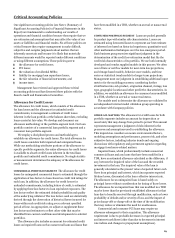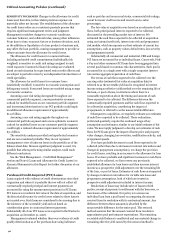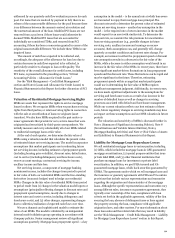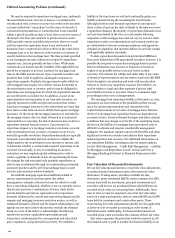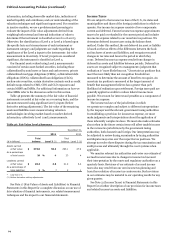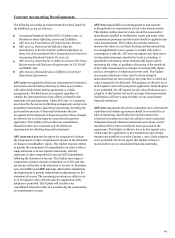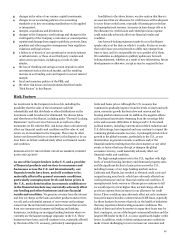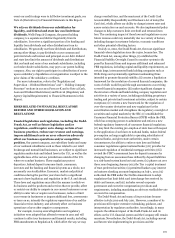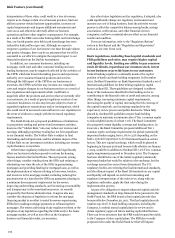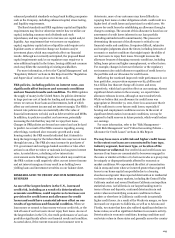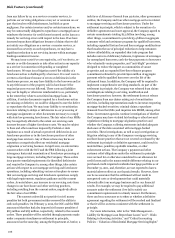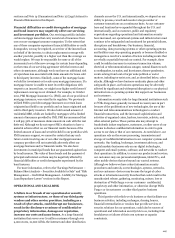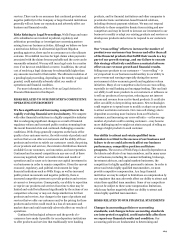Wells Fargo 2011 Annual Report Download - page 101
Download and view the complete annual report
Please find page 101 of the 2011 Wells Fargo annual report below. You can navigate through the pages in the report by either clicking on the pages listed below, or by using the keyword search tool below to find specific information within the annual report.reduce our interest rate risk, we may rebalance our investment
and loan portfolios, refinance our debt and take other strategic
actions. We may incur losses when we take such actions.
We hold securities in our available-for-sale portfolio,
including U.S. Treasury and federal agency securities and federal
agency MBS, securities of U.S. states and political subdivisions,
residential and commercial MBS, corporate debt securities, and
marketable equity securities, including securities relating to our
venture capital activities. We analyze securities held in our
available-for-sale portfolio for OTTI on at least a quarterly basis.
The process for determining whether impairment is other than
temporary usually requires difficult, subjective judgments about
the future financial performance of the issuer and any collateral
underlying the security in order to assess the probability of
receiving contractual principal and interest payments on the
security. Because of changing economic and market conditions,
as well as credit ratings, affecting issuers and the performance of
the underlying collateral, we may be required to recognize OTTI
in future periods, thus reducing earnings. Our net income also is
exposed to changes in interest rates, credit spreads, foreign
exchange rates, equity and commodity prices in connection with
our trading activities, which are conducted primarily to
accommodate our customers in the management of their market
price risk, as well as when we take positions based on market
expectations or to benefit from differences between financial
instruments and markets. The securities held in these activities
are carried at fair value with realized and unrealized gains and
losses recorded in noninterest income. As part of our business to
support our customers, we trade public securities and these
securities also are subject to market fluctuations with gains and
losses recognized in net income when realized and periodically
include OTTI charges. Although we have processes in place to
measure and monitor the risks associated with our trading
activities, including stress testing and hedging strategies, there
can be no assurance that our processes and strategies will be
effective in avoiding losses that could have a material adverse
effect on our results of operations.
Our venture capital business also is subject to market risk and
can be volatile from quarter to quarter. Certain of our venture
capital businesses are carried under the cost or equity method,
and others (e.g., principal investments) are carried at fair value
with unrealized gains and losses reflected in earnings. Our
venture capital investments tend to be in technology and other
volatile industries so the value of our public and private equity
portfolios may fluctuate widely. Earnings from our venture
capital investments may be volatile and hard to predict and may
have a significant effect on our earnings from period to period.
When, and if, we recognize gains may depend on a number of
factors, including general economic and market conditions, the
prospects of the companies in which we invest, when these
companies go public, the size of our position relative to the
public float, and whether we are subject to any resale
restrictions.
Our venture capital investments could result in significant
losses, either OTTI losses for those investments carried under
the cost or equity method or mark-to-market losses for principal
investments. Our assessment for OTTI is based on a number of
factors, including the then current market value of each
investment compared with its carrying value. If we determine
there is OTTI for an investment, we write-down the carrying
value of the investment, resulting in a charge to earnings. The
amount of this charge could be significant. Further, our principal
investing portfolio could incur significant mark-to-market losses
especially if the carrying value of these investments has increased
because of higher market prices.
For more information, refer to the “Risk Management –
Asset/Liability Management – Interest Rate Risk”, “– Market
Risk – Equity Markets”, and “– Market Risk – Trading
Activities” and the “Balance Sheet Analysis – Securities Available
for Sale” sections in this Report and Note 5 (Securities Available
for Sale) to Financial Statements in this Report.
Effective liquidity management, which ensures that we
can meet customer loan requests, customer deposit
maturities/withdrawals and other cash commitments
efficiently under both normal operating conditions and
other unpredictable circumstances of industry or
financial market stress, is essential for the operation of
our business, and our financial results and condition
could be materially adversely affected if we do not
effectively manage our liquidity. Our liquidity is essential
for the operation of our business. We primarily rely on bank
deposits to be a low cost and stable source of funding for the
loans we make and the operation of our business. Core customer
deposits, which include noninterest-bearing deposits, interest-
bearing checking, savings certificates, certain market rate and
other savings, and certain foreign deposits, have historically
provided us with a sizeable source of relatively stable and low-
cost funds. In addition to customer deposits, our sources of
liquidity include investments in our securities portfolio, our
ability to sell or securitize loans in secondary markets and to
pledge loans to access secured borrowing facilities through the
FHLB and the FRB, and our ability to raise funds in domestic
and international money and capital markets.
Our liquidity and our ability to fund and run our business
could be materially adversely affected by a variety of conditions
and factors, including financial and credit market disruption and
volatility or a lack of market or customer confidence in financial
markets in general similar to what occurred during the financial
crisis in 2008 and early 2009, which may result in a loss of
customer deposits or outflows of cash or collateral and/or our
inability to access capital markets on favorable terms. Market
disruption and volatility could impact our credit spreads, which
are the amount in excess of the interest rate of U.S. Treasury
securities, or other benchmark securities, of the same maturity
that we need to pay to our funding providers. Increases in
interest rates and our credit spreads could significantly increase
our funding costs. Other conditions and factors that could
materially adversely affect our liquidity and funding include a
lack of market or customer confidence in the Company or
negative news about the Company or the financial services
industry generally which also may result in a loss of deposits
and/or negatively affect our ability to access the capital markets;
our inability to sell or securitize loans or other assets, and, as
described below, reductions in one or more of our credit ratings.
Many of the above conditions and factors may be caused by
99


